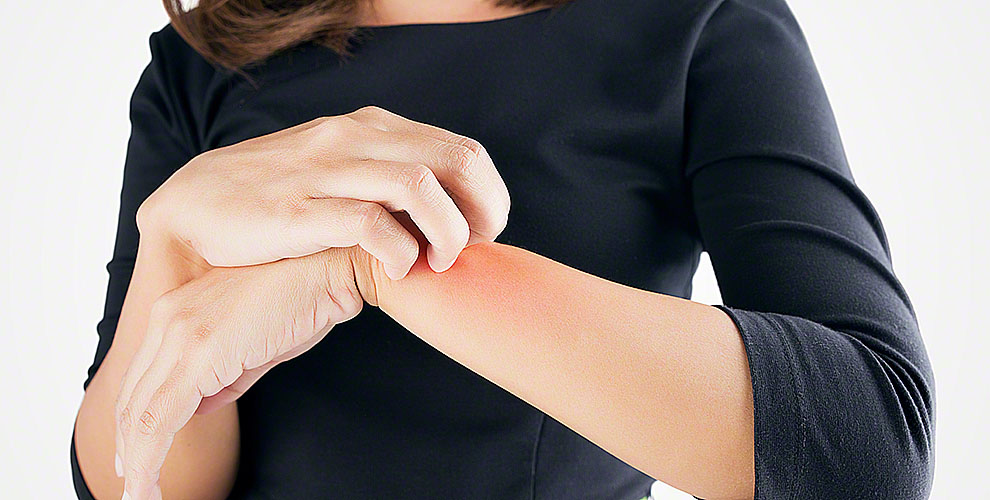Is your skin breaking out in red patches that are itchy and swollen? It might not be the best time to ignore this problem and see an allergy specialist because you may be suffering from a case of chronic spontaneous urticaria. Here is everything you need to know about it.
What Is Chronic Spontaneous Urticaria?
Urticaria, also known as hives is the condition, in which there is a presence of red patches on the skin, that can graduate to welts that are very itchy and, sometimes, painful. Urticaria, caused by allergies, can affect almost 20% of the population and it can be caused by something that triggers the immune system.
However, chronic spontaneous urticaria is different from its traditional counterpart. Chronic spontaneous urticaria is a condition that is characterized by the random occurrence of red welts, patches, and immense swelling (also known as angioedema) with no specific cause. Chronic spontaneous urticaria (CSU) is the recurring/episodic formation of welts and skin swelling for about 6 weeks or more, but, unfortunately, a rock-solid cause can’t be determined, for sure.
Hives/wheals are the red, raised patches on the skin. A lot of the time, these patches can also be paler than your skin color and can be extremely swollen. Wheals can last on the skin for a few minutes or even a couple of days.
Angioedema is a condition in which the deepest layer of the skin and mucous membranes can swell to the point where it can cause temporary physical deformity. Lips, eyelids, cheeks, and chin are a few of the many places where angioedema can occur.
The swollen area of the face can feel itchy, and if you press on it too much, then it can cause a pinching and dull pain. Angioedema can last anywhere between 24 and 72 hours, after which the swelling suppresses naturally or through tried-and-true antihistamines.
The main factor that distinguishes urticaria from CSU is the fact that the latter has no specific trigger or cause and it can be caused “spontaneously”, as the name suggests. Ultimately, pathologists and allergy doctors have termed CSU as being idiopathic.
Symptoms Of Chronic Spontaneous Urticaria
Chronic spontaneous urticaria has the following symptoms, that are strikingly similar to traditional urticaria:
- Formation of red patches on the skin.
- Mostly, the arms, legs, and face are affected.
- Welt blanching is common (the phenomenon of the red welt turning white, when you press on it).
- The urge to itch the skin is unendurable.
- Swelling on the lips, cheeks, and eyelids is also common.
- Swelling and welts can also occur in between the fingers of your hands, and feet as well as on the chest and groin.
There are several risk factors associated with chronic spontaneous urticaria and those include:
- CSU is more common to occur in women and adolescents, as compared to men of the same age bracket.
- Alcohol and other stringent substances can flare up CSU.
- Too much exercise and sweating profusely can also worsen CSU.
- Humidity is also another factor that comes into play and can aggravate the symptoms of CSU.
- Mental ailments like depression, anxiety, and stress can also cause the effects of CSU to spike and it ruins the overall quality of life.
- Out of 3 cases of chronic urticaria, 2 of them can be diagnosed as spontaneous.
- Taking medication like NSAIDs and blood thinning drugs can cause hives to worsen.
- Too tight clothing can also irritate the already swollen and red welts and this can cause severe pain and discomfort, in the long run.
Diagnosis Of Chronic Spontaneous Urticaria
If any of the above-mentioned symptoms are prevalent for more than 6 weeks, you should see a specialist as soon as possible, because it’s highly likely that these hives aren’t normal and you need to get to the bottom of the issue to prevent further problems from rearing their heads.
Usually, a doctor will physically examine your welts. It helps if you have a journal in which you’ve tracked the symptoms as well as their severity and longevity. This is going to be helpful to the doctor for further examination and it’s a very common habit that doctors compel patients to follow because tracking the symptoms is half the battle.
Your allergy doctor also might enquire about any fever, lag in focus, activity, or energy, and the most flared episodes of welts. If there are any associated allergic problems, then those need to be brought out in the open as well. Your doctor might also ask if you’re taking any specific or new medication that might be causing this condition to aggravate.
A lot of the time, certain drugs can compromise the immune system and since CSU is difficult to diagnose on its own, thanks to the absence of a proper cause, it’s up to the medical and health history of the patient that’s will be valuable for the doctor to know.
Blood tests and C-reactive protein (CRP) detection are the baseline diagnostic tools used for ruling out all of the other diseases and for pinpointing chronic spontaneous urticaria. Other differential tests may be done, according to patient history, prevailing medical conditions, and uncontrolled outbursts of reactions.
Treatment Options For Chronic Spontaneous Urticaria
The only way by which chronic spontaneous urticaria can be treated is by treating and alleviating the symptoms. Since there is no definite cause of chronic spontaneous urticaria, the treatment plan is mostly built based on the symptoms and the complications on hand.
Here are some ways by which you can “treat”/alleviate chronic spontaneous urticaria:
Antihistamines
Antihistamines are a godsend when it comes to hives and angioedema. They help to alleviate all sorts of itch-related problems, redness, and swelling and after a couple of doses, you’ll feel like a million bucks.
Allergy Shots
Hives can be dealt with, for good, by allergy shots. Usually, there’s a monthly injection that is administered and it essentially blocks the production of immunoglobulin E (IgE), aka the main culprit of hives and swelling.
Medication
If your symptoms are getting out of hand and allergy medicine isn’t working, then you can try more potent and effective drugs like corticosteroids. These medications will alleviate any and every symptom that allergy medicine can’t seem to control.
Home Remedies
Along with medicinal treatment, there are also at-home remedies that you can try to alleviate the discomfort, if you don’t have allergy medicine on hand.
Try icing on the welts. The shockingly cold temperature is going to numb the area temporarily, hence there will be no urge to itch.
Fill your wardrobe with loose clothes so they don’t rub against your skin. You will feel a lot of difference once you try this tip out.
Take a soft cloth and gently rub it around the perimeter of the welt. This is a better alternative than using your digits and long nails.
Anti-Inch Creams
Use anti-itch creams, as they contain agents that numb the area, hence, preventing you from making your skin bleed as you itch uncontrollably.
Conclusion
Chronic spontaneous urticaria is treatable given that the symptoms are managed and that the treatment methods employed work for you. The pace of action can determine the outcome of this allergic reaction/disorder. So, go to an allergy clinic , as soon as you see the symptoms.


